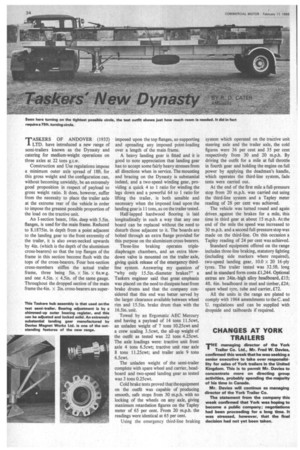Fr ASKERS OF ANDOVER (1932) LTD. have introduced a new
Page 36

If you've noticed an error in this article please click here to report it so we can fix it.
range of semi-trailers known as the Dynasty and catering for medium-weight operations on three axles at 22 tons g.t.w.
Construction and Use regulations impose a minimum outer axle spread of 18ft. for this gross weight and the configuration can, without becoming unwieldy, be an extremely good proposition in respect of payload to gross weight ratio. It does, however, suffer from the necessity to place the trailer axle at the extreme rear of the vehicle in order to impose the greatest possible proportion of the load on the tractive unit.
An I-section beam, 16in. deep with 5.5in. flanges, is used for the main frame. Reduced to 8.1875in. in depth from a point adjacent to the landing gear to the front extremity of the trailer, it is also swan-necked upwards by 4in. (which is the depth of the aluminium cross-bearers) so that the top flanges of the frame in this section become flush with the tops of the cross-bearers. Four box-section cross-members stiffen the actual trailer frame, three being 5in. x 5in. x 6s.w.g. and one .4.5in. X 4.5in. of the same gauge. Throughout the dropped section of the main frame the 4in. x 21n. cross-bearers are super imposed upon the top flanges, so supporting and spreading any imposed point-loading over a length of the main frame.
A heavy landing gear is fitted and it is good to note appreciation that landing gear has to accept some fairly heavy stresses from all directions when in service. The mounting and bracing on the Dynasty is substantial indeed, and a two-speed winding gear, providing a quick 4 to 1 ratio for winding the legs down and a powerful 64 to 1 ratio for lifting the trailer, is both sensible and necessary when the imposed load upon the landing gear is 11 tons, as on the trailer tested.
Half-lapped hardwood flooring is laid longitudinally in such a way that any one board can be replaced without the need to disturb those adjacent to it. The boards are bolted through an extra flange provided for this purpose on the aluminium cross-bearers.
Three-line braking operates triplediaphragm chambers, and an extra blowdown valve is mounted on the trailer axle, giving quick release of the emergency thirdline system. Answering my question of "why only 15.5in.-diameter brakes?" a Taskers engineer said that great emphasis was placed on the need to dissipate heat from brake drums and that the company considered that this end was better served by the larger clearance available between wheel rim and 15.5 in. brake drum than with the 16.5in. unit.
Towed by an Ergomatic AEC Mercury and having a payload of 14 tons 11.5cwt, an unladen weight of 7 tons 10.25cwt and a crew scaling 3.5cwt, the all-up weight of the outfit as tested was 22 tons 4.25cwt. The axle loadings were: tractive unit front axle 4 tons 6.5cwt; tractive unit rear axle 8 tons 11.25cwt; and trailer axle 9 tons 6.5 cwt.
The unladen weight of the semi-trailer complete with spare wheel and carrier, headboard and two-speed landing gear as tested was 3 tons 0.25cwt.
Cold brake tests proved that the equipment on the outfit was capable of producing smooth, safe stops from 30 m.p.h. with no locking of the wheels on any axle, giving maximum retardation figures on the Tapley meter of 65 per cent. From 20 m.p.h. the readings were identical at 65 per cent.
Using the emergency third-line braking system which operated on the tractive unit steering axle and the trailer axle, the cold figures were 36 per cent and 35 per cent respectively from 30 and 20 m.p.h. By driving the outfit for a mile at full throttle in fourth gear and holding the engine on full power by applying the deadman's handle, which operates the third-line system, fade tests were carried out.
At the end of the first mile a full-pressure stop from 20 m.p.h. was carried out using the third-line system and a Tapley meter reading of 28 per cent was achieved.
The vehicle was turned round and again driven , against the brakes for a mile, this time in third gear at about 15 m.p.h. At the end of the mile the speed was increased to 30 m.p.h. and a second full-pressure stop was made on the third-line. On this occasion a Tapley reading of 24 per cent was achieved.
Standard equipment offered on the range includes three-line braking, statutory lighting (including side markers where required), two-speed landing gear, 10.0 x 20 16-ply tyres. The trailer tested was 32.5ft. long and in standard form costs £1,244. Optional extras are 24in.-high alloy headboard, £15; 4ft. 6in. headboard in steel and timber, £24; spare wheel tyre, tube and carrier, £72.
All the units in the range are plated to comply with 1964 amendments to the C. and U. regulations and can be supplied with dropside and tailboards if required.




























































































































